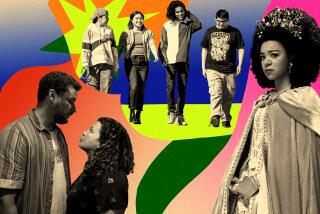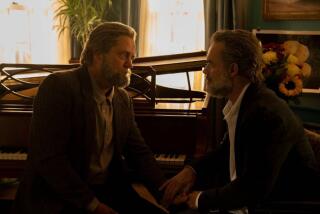Good vs. Bad on TV: Check the Scorecard
No one rational would argue against slashing gratuitous television violence. Obnoxious murders, knifings, beatings, you name it. They’re relentless, ranging across all of television, at the very least creating an aura of unreasonable fear that affects the way we live our lives.
Is it possible, for example, that such TV-fed paranoia was behind the fatal shooting of a 16-year-old Japanese exchange student in Baton Rouge, La.? Rodney Peairs, the man who shot Yoshi Hattori, was found not guilty of manslaughter recently after a trial in which his wife testified that when the youth mistakenly arrived at their suburban home looking for a Halloween party, she screamed, slammed the door and called to her husband to get his gun. Peairs said that he shot Hattori with a .44-caliber Magnum after the youth--whose “crime” was ringing a doorbell--failed to acknowledge a command to “Freeze!”
Is it also possible that a recent ABC movie about a mass murderer triggered copycat killings? In Canada, a 17-year-old has been accused of murdering his 13-year-old girlfriend’s mother and brother, allegedly after watching “Murder in the Heartland,” which depicted 19-year-old Charles Starkweather slaughtering members of his 14-year-old girlfriend’s family as part of a killing spree.
“Murder in the Heartland” was vilified at a hearing on TV violence held last week by a Senate subcommittee headed by Sen. Paul Simon (D-Ill.). Under pressure from Simon, top executives of the major broadcast networks have vowed to curtail depictions of violence, and the entire TV industry has set an Aug. 2 conference in Los Angeles to discuss the matter.
The conference is a good idea; making television a scapegoat is a bad idea.
It’s human nature to seek easy answers to complex questions. Rather than acknowledge the root causes of violence as being deep and complicated, there’s a tendency on the part of many to automatically blame television. As if the Canadian teen-ager accused of slaying his girlfriend’s family would have led a peaceful life had not “Murder in the Heartland” pushed his button.
Some critics of the industry cite the number of violent acts that U.S. children supposedly see on TV as circumstantial evidence of linkage between growing real-life violence and TV violence. The American Psychological Assn., for example, says that thanks to TV, the average U.S. child sees 100,000 acts of violence--including 8,000 murders--before completion of elementary school.
And “children clearly imitate,” said a senator at that recent TV violence hearing in Washington.
Yet if so--if what’s on television is a determining factor in society’s violence level--America should be getting more peaceful, not less so. When it comes to sheer numbers, television programs readily available to children convey mostly positive messages, not antisocial ones. If young kids are exposed to 100,000 acts of violence via TV, they’re surely exposed to at least 200,000 acts of goodness as well. Are we to believe that bad acts have twice or triple the impact of good acts?
In any event, consider the small test I conducted three nights this week, counting positive and negative influences in blocks of prime time likely to be watched by kids.
*
On Monday night, I watched two comedies and a docudrama on NBC:
* “Fresh Prince of Bel-Air.” In this rerun of the pilot episode, Will, the protagonist, hugged a butler. He hugged his aunt. His aunt and uncle kissed. Will kissed his little cousin. She gave Will a painting. Will took time to listen to her problems. The episode’s final message was this: Before you criticize someone, understand what he’s all about.
On the negative side, Will used bad table manners.
Score: Good over bad, 7 to 1.
*”Blossom.” In this rerun, teen-age Blossom got groceries for a shut-in. Blossom’s friend comforted her. Blossom’s father expressed his love for her. Blossom and her dad hugged. One of Blossom’s brothers exhibited sensitivity about Blossom getting her first period. The episode ended on a note of family togetherness.
On the negative side, Blossom was teased by her brothers. Blossom told a lie to her dad. One of her brothers made light of drugs.
Score: Good over bad, 6 to 3.
* “Triumph Over Disaster: The Hurricane Andrew Story.” A wife and husband hugged. A Miami TV weatherman worked around the clock to help citizens. Other TV news people performed valiantly. A station manager was kind to his staff. Victims of the hurricane selflessly helped each other. People defeated adversity. A woman refused to leave her dying husband. A boy disobeyed his parents and took their boat out as the storm neared, but paid a terrible price for his action and later agreed he had erred, making this a positive message.
On the negative side, the boy screamed at his father and played loud music just to irritate him. A looter stole a TV set from a devastated house. Other looters were shown stealing.
Score: Good over bad, 8 to 3.
*
On Tuesday, I watched repeat episodes of three popular ABC comedies:
* “Full House.” Jesse hugged his niece. Teen-ager D. J. took a courageous stand, knowing the consequences. Jesse realized that his family was more important to him than fame. Jesse and his wife hugged. While touring Japan, Jesse showed respect for Asian culture. Jesse kissed his niece.
On the negative side, the show was so bad that I almost committed an act of violence against my TV set. But that doesn’t count.
Score: A shutout, good over bad, 6 to 0.
* “Hangin’ With Mr. Cooper.” Nine-year-old Tyler learned that it’s sometimes better to do things yourself instead of relying on others.
On the negative side, Mark, the protagonist, ridiculed little Tyler. Tyler spilled honey on the floor. Men viewed women as sex objects. People lied.
Score: Bad over good, 4 to 1.
* “Roseanne.” When their friend, Nancy, revealed that she was a lesbian, Roseanne and her sister responded calmly, affirming that people deserve respect, regardless of their sexual orientation. Roseanne showed affection for her mother. Her mother demonstrated that there was no shame in growing old.
There was nothing negative.
Score: Another shutout, good over bad, 3 to 0.
*
On Wednesday, I started off with KCOP’s syndicated “Star Trek: The Next Generation” in advance of prime time, then watched reruns of two more hit ABC comedies before switching to NBC for a docudrama.
* “Star Trek: The Next Generation.” The story preached that there is joy in variety, that we should celebrate differences, not necessarily seek uniformity. There was another message--that it’s all right for friends to argue.
No negatives.
Score: Another wipeout, good over bad, 2 zip.
* “Home Improvement.” Although the result was chaos, Tim showed that it was only fair for two-career couples to share household duties.
No negatives.
Score: Good over bad, 1 to 0.
* “Coach.” Kelley selflessly gave $50,000 to charity.
On the negative side, her father gave the impression that lying was fine.
Score: A 1-1 tie.
* “Without Warning: Terror in the Towers.” This was NBC’s movie about the devastating bomb explosion at New York’s World Trade Center. It focused on personal bravery, affirming that disaster brings out the best in some people. It also demonstrated that coolness under fire pays.
On the negative side, there was the bombing itself, which took six lives and injured scores.
Score: Good over bad, 2 to 1.
*
Totaling the 10 shows I watched, good clobbered bad 37-13. And among the 13 negatives, only the bombing involved violence. Perhaps I happened to be tabulating at a time when TV was unusually virtuous, but I doubt it.
Granted, my definitions of “good” and “bad” are subjective, but so are many of the arguments blaming violence in real life on violence in television.
More to Read
The complete guide to home viewing
Get Screen Gab for everything about the TV shows and streaming movies everyone’s talking about.
You may occasionally receive promotional content from the Los Angeles Times.






